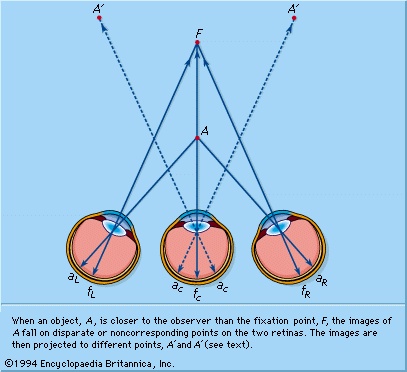double vision
physiology
also called diplopia
 perceiving of two images of a single object.
perceiving of two images of a single object.Normal binocular vision results from the brain's fusion of slightly different images from each eye (eye, human), with points on the retina of each eye corresponding to points on the retina of the opposite eye. Binocular diplopia occurs when the eyes are not properly aligned, and the image of an object that projects onto one retina does not fall spatially to the matching point on the other retina. In such a situation, the double image is eliminated when either eye is covered. It is commonly caused by temporary or permanent paralysis or restriction of one or more of the external eye muscles (muscle). The orientation of the double image is determined by the particular muscle (sometimes more than one muscle) that is not working properly.
Causes of binocular diplopia include myasthenia gravis, inflammatory (inflammation) processes, thyroid (thyroid gland) eye disease (Graves ophthalmopathy), small blood vessel disease (e.g., diabetes mellitus), trauma, infections, and various tumours (tumour). These processes usually induce diplopia by impairing the external eye muscles themselves or the nerves that directly or indirectly control their function. However, an underlying cause of diplopia is not always found. Frank displacement of the eyeball, via large orbital fractures or a mass pressing on the eyeball, can also cause double vision.
The treatment for binocular double vision varies depending on the cause, severity, and duration. Many cases of diplopia resolve on their own and require only temporary patching of one eye to eliminate the offending second image. People with permanent diplopia may benefit from prisms placed in eyeglasses or from surgical realignment of the eyes. Of course, treatment of underlying diseases or injuries is also essential.
Misalignment of the eyes in early childhood is a special situation. It usually does not result in symptomatic diplopia, as the child's developing brain suppresses the second image. Without correction, this often leads to amblyopia and permanent vision loss in the “suppressed” eye.
Monocular diplopia differs from binocular diplopia in that the double vision remains present when the nonaffected eye is covered. Monocular diplopia is due to abnormalities in the structure of the eyeball itself, most notably the lens and cornea. Treatment is directed at correcting the abnormality.